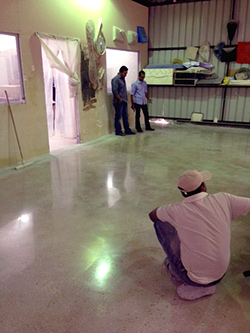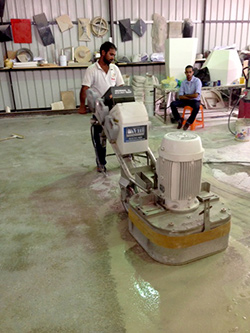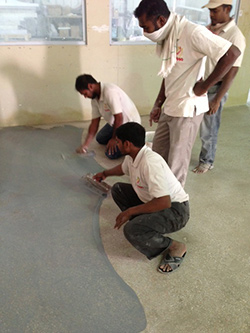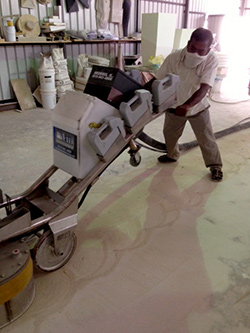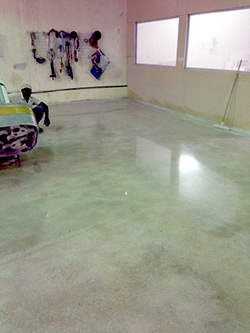Soft Concrete Problems Solved by STI – Saudia Arabia
When Josh Jones, President of STI, arrived in Riyadh, Kingdom of Saudi Arabia, he had no idea what the concrete was going to be like. Based on his experience with concrete from all over the world, he could only imagine what the difficulties would be.
When he reached the job site, he knew that this was going to be a unique experience, and one which would test all of his knowledge and experience with polishing concrete.
The concrete on the job site was typical of what is available in the region. The concrete was incredibly soft because of local aggregate and placement methods. He also noticed a large crack in the slab that was going to need to be patched. The only way to find out what to do was to start grinding.
Using the Prep/Master® 3030 he decided to start out conservatively with a non-aggressive diamond tool. The EG 70 grit ten-segment diamond seemed like a good starting point.
After the first grind was completed, it was clear that the 70 grits were cutting like 30 grits. Voids were everywhere on the surface and this was going to have to be addressed before any resin polishing could begin.
Strengthening the Concrete
Jones decided he had to do something to increase the strength of the concrete so he densified the surface with an application of colloidal silicate densifier. This increased the strength of the floor and also helped to prolong the life of the diamonds.
After the densifier was dry, the crew went back to grinding with the EG ten-segment (10S) diamonds. This time the cut was much better and the surface was ready to accept a skim coat. The ingredients for the skim coat were sourced locally, and the recipe was as follows: 50% Portland cement and 50% Polybond acrylic.
Mr. Jones then instructed the crews on how to hand trowel the skim coat evenly across the surface. It took three applications to fill in all the voids and cracks.
When this was completely dry, the 70 grit EG 10S diamonds were switched out to 120 grit EG Daisy Cutter-12 diamonds. The decision to cut wet achieved two goals: first, it gave a clean, consistent scratch pattern that was uniform across the surface, and second, it allowed for removal of overfill without removing patch from the holes.
After the slurry had been cleaned up, the surface was allowed to dry and was inspected for rogue scratches. Then, the second application of colloidal silicate densifier was applied per the manufacturer’s recommendations.
Making the Transition
Next came the transitional step: FL-07 #4C. Mr. Jones decided to use the FL-074C for the transitional step because it gave him the ability to thoroughly remove all metal scratches and prepare the surface for resin polishing. The crew ran the diamonds wet first and after a small sample to see how it preformed, it was determined that everything was done.
Again the slurry was cleaned up and the floor allowed to dry. Mr. Jones also inspected the floor for any scratches that didn’t get replaced with the FL-07 #4C’s and was satisfied with what he saw.
Once the floor dried the crew ran the FL-08 series from #5 all the way to #8, and as you can see by the pictures the floor turned out just fine. Mr. Jones stated that, “this was a testament to the durability of the machines and tools to polish even the most difficult slabs as long as proper steps are taken to prepare the concrete for full refinement.”
This job was another indicator that given the right machinery, tools, chemicals, and training most any concrete slabs can be polished.
